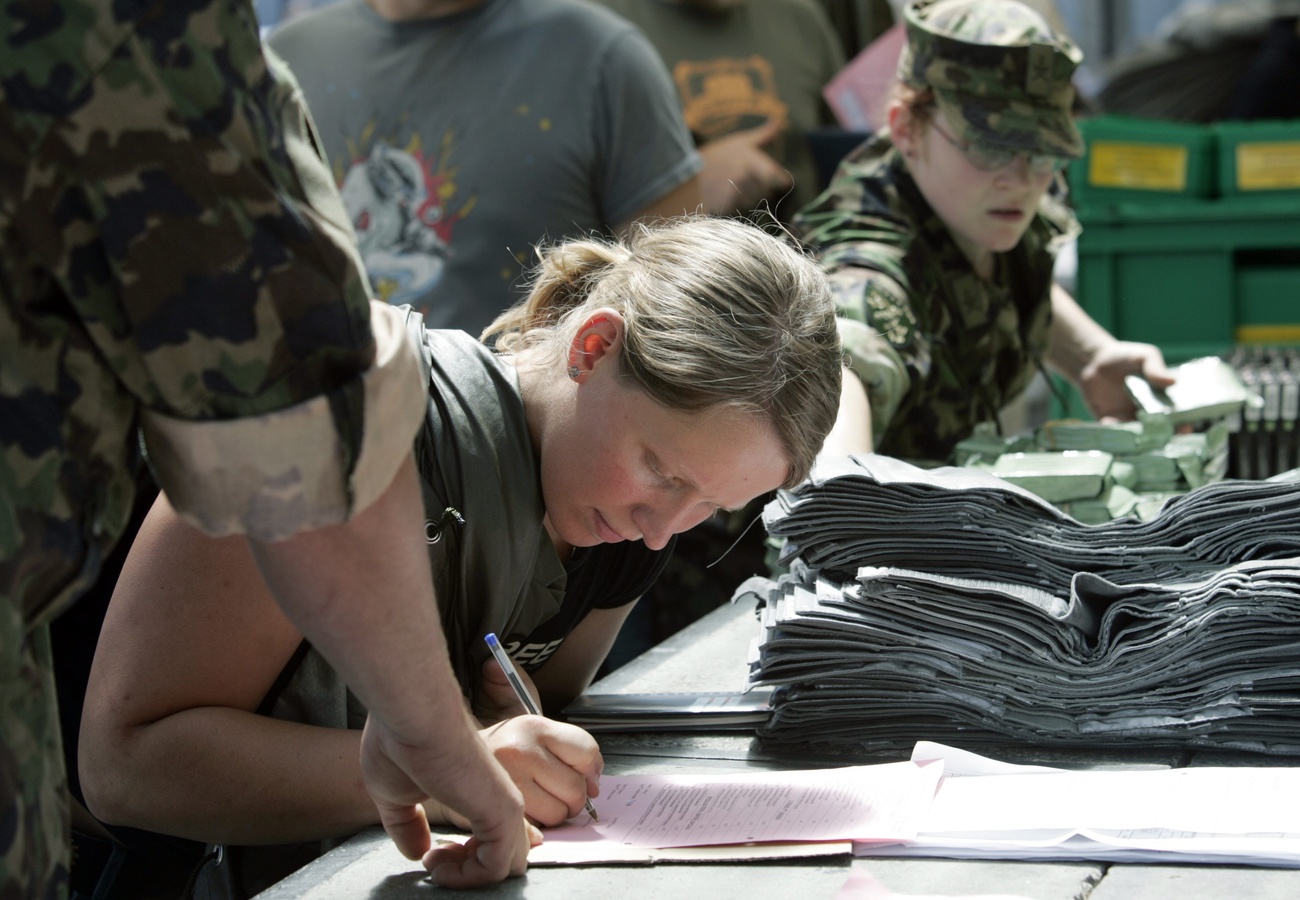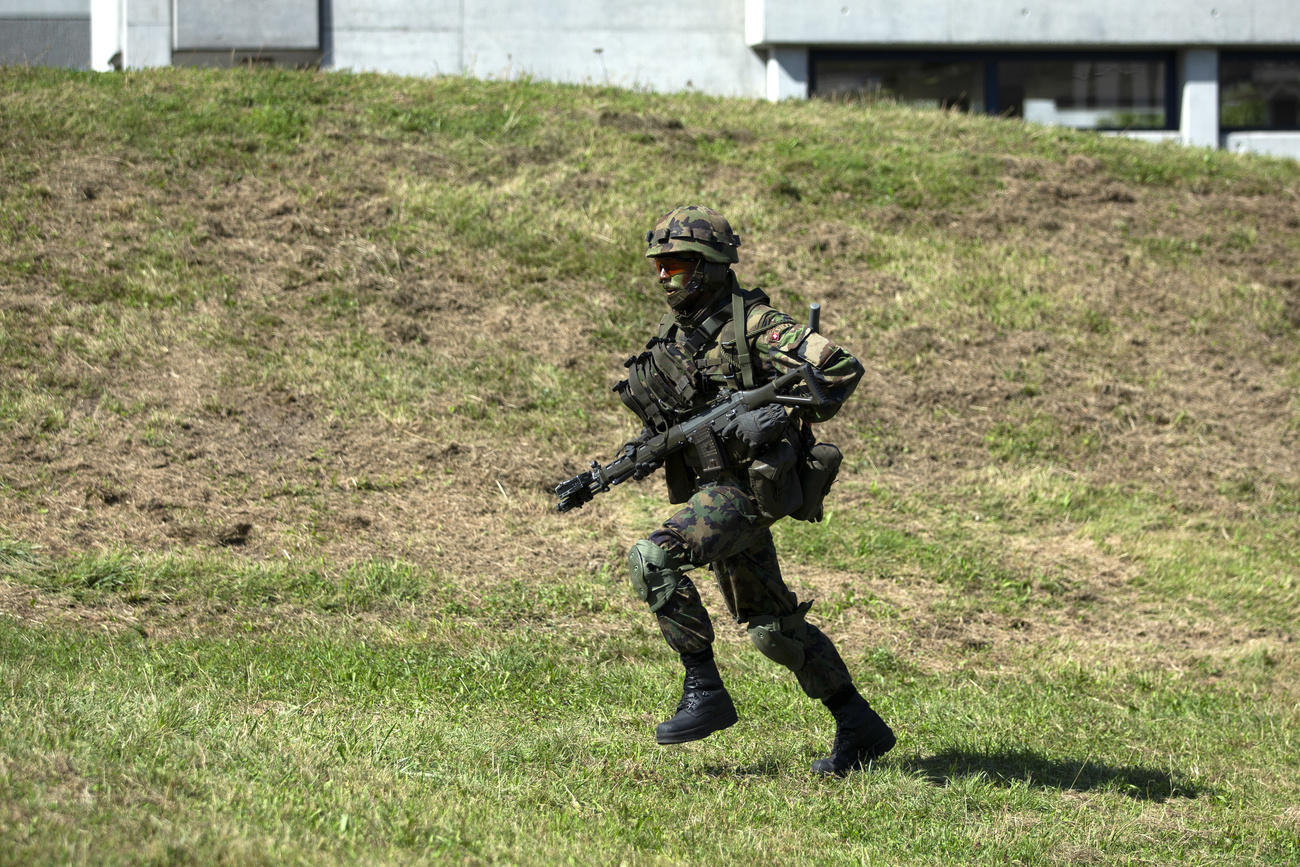
Drafting women into the army the Norwegian way

The Swiss defence ministry is studying the option of drafting women into the army as part of a larger effort to boost the military. What can Switzerland learn from Norway, the country that inspired the gender-neutral conscription model currently under review?
For years now the Swiss army has known that it needs to change fundamentally to avert a future shortage of soldiers. Yet the idea of drafting women was never considered a politically popular solution – that is, until the Norwegian parliament voted overwhelmingly in favour of introducing gender-neutral conscription in 2013 with a logic that has since resonated with the Swiss.
“We are a small country and need the best people out there,” says Danel Hammer, diversity and gender adviser with the Norwegian Armed ForcesExternal link. “We cannot risk limiting our recruitment to only one gender.”
Today the Swiss defence ministry is studyingExternal link the merits of a “needs-based obligation to serve”, which would see women be conscripted alongside men in a system inspired by the Norwegian example. The ministry has until 2024 to table a detailed report to the Federal Council (executive body) on this and two other options for boosting the army, which currently expects to have trouble meeting a target of 140,000 personnel by the end of this decade.
The ministry’s review begins against the backdrop of war in Ukraine, which has prompted questions about military strength and readiness in Switzerland, as it has in other countries. It also comes on the heels of a public debate on gender equality amplified in recent years by events like the 2019 women’s strike.
Norway’s experience, however, suggests that bringing – and keeping – women in the military would take more than just a legal obligation to serve.
Broadening the talent pool
As Hammer pointed out, the Scandinavian state is putting the emphasis on recruiting the best. Accordingly the selection process is rigorous under the gender-neutral system put in place in 2015. All 19-year-olds have to fill out a lengthy questionnaire for the armed forces, which then invite the most eligible candidates for tests and interviews.
Out of about 60,000 youth, around 10,000 are chosen each year for service, which lasts up to 19 months. Following basic training, most of them are transferred to the Home Guard, the military’s quick mobilisation force, and can be called up for one week of training each year. By sheer numbers alone, conscription has been a success: the proportion of female conscripts rose from 17% in 2015 to 32% in 2021, according to the armed forces.
The fact that just a fraction of the cohort is drafted has made military service highly competitive and desirable, says Nina Hellum, a researcher at the Norwegian Defense Research Establishment (FFI).
“If it’s exclusive, people want it,” she says. “The reputation of the military is quite good in Norway, so it’s also very good to put on your CV.”
The Swiss model under review would be selective too, as the army would recruit only the people it needs. But just how motivated young people would be to serve under an expanded draft system is unclear. Whereas a stint in the army was once seen as an essential career move, by the time the alternative civilian service was introduced in the 1990s it became almost fashionable for young Swiss men to object to military service. Among those who do sign up today, many choose to postponeExternal link their refresher courses as careers or studies come first.

More
Is it possible to refuse military service in Switzerland?
The Swiss army may have an even harder time convincing women, who currently can join voluntarily and make up just 0.9% of army personnel. The defence ministry speculates that few end up in the military for lack of knowledge about what the institution has to offer. All 18-year-old men are obliged to attend an army information day – women can opt in – but the ministry is now studying the option of making it mandatory for women as well.
Hellum believes this could be a good way to pique their interest. Before conscription, she says, “the average woman in Norway would not think much about the military” as a career option. Going through physical and mental tests, attending interviews and getting more information directly from the armed forces can be eye-opening experiences.
“That’s somewhat increased the percentage [of women recruits] – just making them see there are many opportunities in the military,” she says. “You can be a chef or a nurse or you can join logistics.”
A matter of equality
Drafting women also works in Norway because it fits into the country’s values system which, like in other parts of Scandinavia, prizes gender equality. The parliamentary vote to extend conscription to women took place the same week in 2013 that Norway celebrated 100 years of the women’s right to vote.
Public approval for the draft is high: 78% of the population in 2021 agreed the new conscription model should be retained.
“In Nordic countries, turning to gender-neutral conscription was palatable for the public,” says Sanna Strand, a research fellow at the Austrian Institute of International Affairs who specialises in military recruitment. Her native Sweden introduced a draft system similar to Norway’s in 2017. “But that is not a given in all contexts and in all countries,” she adds.
In Switzerland, a draft for women would require a change to the constitution, which voters would first need to approve. Support for compulsory service for men and women has grown by 14 percentage points since 2015, reaching 67% in 2021, according to a surveyExternal link by the Centre for Security Studies (CSS) at the federal technology institute ETH Zurich. The CSS speculates this shift may be due to a more prominent public debate about gender and a growing number of women joining the security sector. The country gained its first female defence minister, Viola Amherd, in 2019 – she has made it her priority to recruit more women into the military and is aiming for 10% female staff in 10 years.
All able-bodied Swiss men must start military serviceExternal link roughly between the ages of 19 and 25 and return for regular refresher courses. Conscientious objectors can opt for the alternative civilian service, which they can complete in institutions like hospitals or care homes.
Women, for their part, have been able to serve voluntarily alongside men since 1995. Since 2004, all roles in the army have been open to them.
Under the “needs-based obligation to serve” model, the army would recruit staff for both the army and civil defence service according to needs. No one would be forced to serve against their will.
The defence ministry is also studying two other options for boosting the army. One is the “obligation to serve in security”, which would see the civil defence and civilian services merging to form a new organisation. The other option is to oblige women to take part in an information day about the army and civil defence.
If adopted, any one of these options would require a change to the constitution.
The minister supported a motion in parliament earlier this year to make the army information day mandatory for women, sayingExternal link “it would be a start, in a context where gender equality and equal treatment are constantly being discussed.” Her department has taken several steps to attract more female recruits, including naming a diversity adviser and opening a unit dealing with gender issues.
None of this means the country is ready to accept gender-neutral conscription, however. Even Amherd assured parliament that obliging women to attend an information day was not the same as mandatory service for women. Plus, in a survey done for a ministry reportExternal link on boosting the army published earlier this year, some participants said it was probably too soon to extend the draft to women given that equality in other areas of society, such as the workplace and childcare, had not been achieved.
Women’s associations also worry that attending regular refresher courses – which currently last three weeks each – would create a greater career disadvantage for women, as the distribution of parental leave means mothers already log in longer absences from work than fathers do (14 weeks versus two weeks, respectively. In Norway, new parents can choose to share equally a combined 48 weeks of leave.)
Recruiting – and retaining
A change to the draft system also offers no guarantee that more women will choose a career in the army. The percentage of women occupying military positions in the Norwegian Armed Forces stood at 15% in 2021 – up from 10% in 2015. Fewer still end up in the upper ranks – just 11% of officers are women.
“Having a law on gender-neutral conscription does not automatically translate to a gender-equal force either in quantitative or in qualitative terms,” Strand cautions.
Hammer, the gender adviser, concedes that progress has been slow in some areas: “We do believe that the relatively low representation of women across some parts of the military will affect women’s potential to want to stay in the armed forces.” Recruiting regardless of gender, from conscription to specialist or officer rank, is a priority, she adds.
The forces are also working on improving conditions for women, including adjusting uniforms, adapting barracks and other facilities, offering co-ed boardingExternal link to encourage integration, and giving more support to service members with families. Making tampons and other sanitary products freely available to women soldiers in the field, for example, “sends a strong signal”, says Hammer.
But the military also needs to address job satisfaction. Even though the Norwegian Armed Forces have an equal pay policy, more women than men end up leaving. Both sexes cited similar reasons for their decision, such as studies or a new job, in a 2020 survey, says Kari Roren Strand, a researcher at the FFI.
“They were often not satisfied with their careers or future career possibilities in the organisation,” she says. “The women were a bit more dissatisfied with their leader and felt more ‘finished’ with the armed forces.”
Few women (3%) cited sexual harassment or bullying as a reason for leaving, even though another 2020 survey shows that 40% of female staff and conscripts reported experiencing some form of sexism in the previous 12 months.
For all the progress made on equality, in both Norway and Sweden men are still more likely than women to say they are motivated to join the military. Sanna Strand speculates this is due to certain persistent social expectations.
“There are huge implications [for decision-making] if young people can see themselves as a soldier or not,” she says. “And the soldier is something that still has masculine connotations.”
More

In compliance with the JTI standards
More: SWI swissinfo.ch certified by the Journalism Trust Initiative
































You can find an overview of ongoing debates with our journalists here . Please join us!
If you want to start a conversation about a topic raised in this article or want to report factual errors, email us at english@swissinfo.ch.